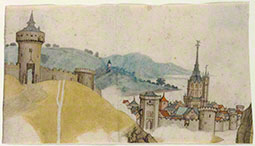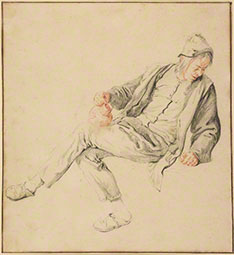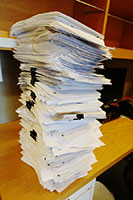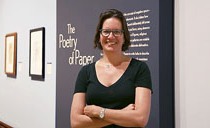|
This exhibition of drawings explores the concept of negative space—the unoccupied ground around drawn elements. It elucidates how artists deliberately left areas of paper blank to create the illusion of light and form, using absence to evoke a sense of presence.
For select drawings, the curator chose to write haiku—an unrhymed, three–lined poem—to describe how empty passages contain meaning. Employing only seventeen syllables in three lines to conjure an image or idea, these haikus complement the artful restraint of the works on view.
|
 |
|
Slope of languid head
Against suggested pillow
Peacefully resting
When drawing human figures, artists frequently used negative space to suggest form, trusting the viewers imagination to interpret the empty passages. Here, for example, a blank area demarcated by a curved line adjacent to a resting head can be read as a pillow.
|
 |
|
Blinding messenger
Radiates eternal light
Glorious aura
In compositions featuring religious subjects, artists often employed dramatic light effects to suggest a divine presence. Here, areas of untouched white paper interspersed among dark wash or chalk could convey an ethereal glow, giving an otherworldly appearance to a messenger of God.
|
 |

 |
 |
View of a Walled City in a River Landscape, about 1485, attributed to the workshop of Master LCz
|
 |
 |
Blank expanses form
Fog dense as citadel walls
Old city shrouded
Inspired by the world around them, artists strove to capture what they witnessed in nature. By juxtaposing areas of bare white paper with various colors of wash, this artist suggests fog engulfing a walled city.
|
 |
|
Held up by columns
Of only paper and shade
Dome of the heavens
Artists—utilized negative space in their renderings of architecture. Leaving areas around drawn elements untouched was an efficient way to suggest the effect of light streaming into a building or shining on a column, arch, or dome.
|
 |
|
Exhibition visitors are invited to reflect upon the use of negative space in two drawings. View a selection of their haikus on Pinterest.
|
 |
|
When the exhibition opened, I wasn't sure that our visitors would find this exercise compelling. It turns out they did. On average, I've received 700 haiku a week, and 155,000 people have come to see the show so far. Keep Reading
|
 |
|

|
 |
|
Why would a curator write exhibition labels with only 17 syllables? Drawings curator Stephanie Schrader uses haiku to invite us to look at Old Master drawings in a new and unusual way. Keep reading...
|
 |






